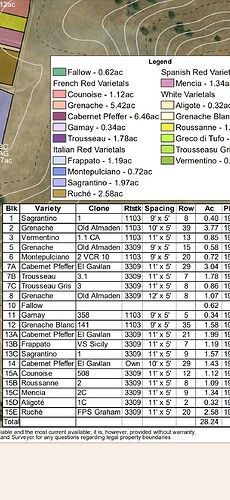That’s definitely very obscure, since not only does Wine Grapes have no mentions of the variety, but neither does VIVC, which basically has an entry for every single grape variety imaginable.
What confuses me, though, is how the website of Scolaris names the wine as “Oĉelot (Malbec Alta Collection)”. I know they used to farm Malbec in Friuli in the past, so this makes me wonder whether Oĉelot is a unique variety or just a very obscure synonym for Malbec.
Indeed, Merlot Blanc is a rare white variety. A Merlot x Folle cross, as you said.
They claim to be the only producer of Caberlot, so possibly not. I don’t know whether any original vines, from which the Carnasciale plantings were taken, survives, or if there have been other cuttings than those of Il Carnasciale.
However, since they have not allowed the variety to be genetically tested, it still remains unknown whether Caberlot is truly a unique variety (often claimed to be a Cabernet Franc x Merlot cross or a cross of Merlot and an unknown variety) or just a clone of Merlot or Cabernet Franc.
You made just a general search. Almost all of these were just red blends with the term “Caberlot” in their name. If you search only for the variety, that single Albanian bottle is the only one that isn’t Il Carnasciale.
To my understanding, there are Cab Pfeffers that have been identified as Mourtaou, and others that are not. I have no idea to which group the wine I tasted belongs to. However, I’ve never had a Mourtaou.
While the Tsitska wines have been always nice, I haven’t thought it was anything particularly distinctive. I’m more partial to Kisi, but some people think its somewhat floral-spicy overall character can get a bit overwhelming. Mtsvane is another somewhat more characterful variety.
But as an overall observation: I think varieties that are just not available at the local market don’t really qualify as “weirdo or oddball grapes”. If that were the case, I could argue varieties like Zinfandel or Chenin Blanc would be weirdo or oddball varieties because at some point there were just 1 or 0 examples available here in the Finnish market.
So while you might not have seen much Lagrein or Schiava or Marselan or Douce Noir or Seyval Blanc, I would argue they are far from oddball varieties. For example Lagrein and Schiava are some of the most widely-planted red varieties in Alto Adige and Schiava (aka. Trollinger) is probably the most popular red variety in the large wine region of Württemberg. Douce Noir used to be the most grown variety in Argentina (as Bonarda) and is also grown in California as Charbono. Seyval Blanc is one of the most popular hybrid varieties and there are thousands of acres of Marselan vineyards in France and there are hundreds of acres elsewhere: not only is the variety grown also in California, but I’ve also had examples from Spain, Argentina and even China.
However, to me, most other varieties mentioned here are pretty rare and obscure.


